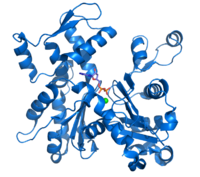
Photo from wikipedia
Contractile injection systems generate 500 pN forces for membrane puncture by a domino-like collapse of sheath subunits. Contractile injection systems (CISs) [type VI secretion system (T6SS), phage tails, and tailocins]… Click to show full abstract
Contractile injection systems generate 500 pN forces for membrane puncture by a domino-like collapse of sheath subunits. Contractile injection systems (CISs) [type VI secretion system (T6SS), phage tails, and tailocins] use a contractile sheath-rigid tube machinery to breach cell walls and lipid membranes. The structures of the pre- and postcontraction states of several CISs are known, but the mechanism of contraction remains poorly understood. Combining structural information of the end states of the 12-megadalton R-type pyocin sheath-tube complex with thermodynamic and force spectroscopy analyses and an original modeling procedure, we describe the mechanism of pyocin contraction. We show that this nanomachine has an activation energy of 160 kilocalories/mole (kcal/mol), and it releases 2160 kcal/mol of heat and develops a force greater than 500 piconewtons. Our combined approach provides a quantitative and experimental description of the membrane penetration process by a CIS.
Journal Title: Science Advances
Year Published: 2021
Link to full text (if available)
Share on Social Media: Sign Up to like & get
recommendations!